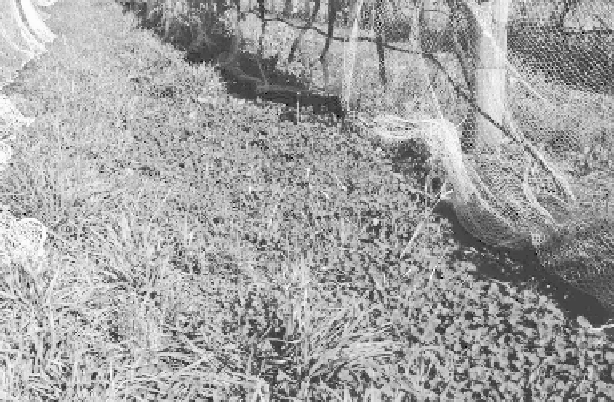Agriculture Reference
In-Depth Information
Figure 5.7
A white clover-fescue cover crop late in the season in a vineyard in the
Mornington Peninsula region, Victoria, Australia.
competition for water. Maintaining a cover crop during summer in low-rainfall
regions is difficult where drip irrigation is used. Other possible disadvantages of
a cover crop are that it may harbor pests such as the light-brown apple moth,
although this is less of a problem if the cover crop is oats, faba beans, field peas,
lupins, or mustard rather than other broadleaf species. There can also be a buildup
of snails that attack young vines in areas sown with cover crops.
Perennial cover crops are more common now in Australian vineyards, particularly
in the higher rainfall regions. Growth of the cover crop can be controlled by mow-
ing and/or herbicides, or by sheep grazing while the vines are dormant. Figure 5.8
shows an example of the latter practice. Sometimes a cover crop may be allowed to
spread under the vines, to be controlled with herbicides or cultivation when necessary.
Grasses with their fibrous root systems are better for improving soil structure than
legumes and generally add more organic matter. For annual grasses, regeneration is
encouraged if the grasses are allowed to seed in early summer.
An under vine mulch created with mowings from a cover crop helps to sup-
press weeds and slowly builds up SOM. Other benefits of mulch are discussed in
“Mulches, Soil Water, and Temperature” in chapter 4. Heavy applications of a mulch,
such as cereal straw or composted cereal straw, can be effective in building up SOM.
For example, Figure 5.9 shows the excellent result from an application of 100 m
3
/ha
of straw composted with pig manure in a vineyard on a degraded granitic soil in the
Hilltops region in New South Wales, Australia. After 18 months the A horizon, now
enriched with organic matter, has developed a mellow, friable tilth. Although this
heavy application of composted straw was incorporated into the soil quite quickly,
uncomposted cereal straw and particularly wood chips last much longer as mulches.

